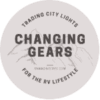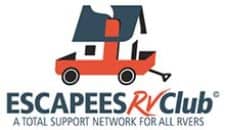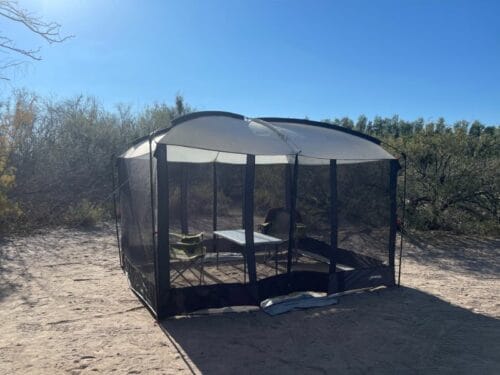My favorite way to travel is by motorcycle. There’s just something about being on a bike that makes you feel alive. You’re constantly on the move, and you can go anywhere you want.
Are you longing for the open road? Do you want to see the world but don’t want to leave your job behind? Whatever your reasons, becoming a digital nomad on a motorcycle is a great way to see the world and live a life of adventure.
You need to know a few things before hitting the road, though. In this step-by-step guide, I’ll show you everything you need to become a digital nomad on a motorcycle, from choosing the right bike to navigating the open road; I’ve got you covered. I’ve biked quite a few thousand miles myself, so let’s get started!

WHO IS THIS ARTICLE FOR?
This article is for anyone who wants to become a digital nomad on a motorcycle. I’ll assume you have some basic knowledge of motorcycles and motorcycle maintenance. If you’re new to motorcycles, this guide will still be helpful, but I recommend doing some additional research before hitting the road.
WHAT YOU NEED TO BECOME A DIGITAL NOMAD ON A MOTORCYCLE
You’ll need a few things before hitting the road as a digital nomad on a motorcycle. Here’s what you’ll need:
- A bike that’s in good mechanical condition and has been serviced recently
- A valid driver’s license and registration
- Insurance for your motorcycle
- A motorcycle license (if required in your state or country)
- The proper gear for riding a bike (helmet, gloves, boots, etc.)
- A place to store your belongings while you’re on the road
- A laptop or tablet with WiFi capabilities
- An income source that you can access remotely, like freelancing, blogging, or working for a remote company
WHAT GEAR DO YOU NEED FOR RIDING A MOTORCYCLE?
There’s more to riding a motorcycle than just hopping on and taking off. You need the proper gear to stay safe on the road. Here’s a list of essential motorcycle gear:
- Full-face helmet
- Armored gloves
- Racing boots
- Off-road biker jacket
- Cruiser pants
5 STEPS TO BECOMING A DIGITAL NOMAD ON A MOTORBIKE
Picking the Right Motorcycle
Not all motorcycles are created equal, and some are better suited for life on the road than others.
Obviously, steer clear of sport bikes. Cruisers, Standards and Sports are perennial favorites. If you don’t want to lose the get-up-and-go of a crotch rocket, check out a dual-sport bike. Or you might want a trike, which sacrifices some of the sportiness of a 2-wheeler for better straight-line stability.
If you plan on spending a lot of time on the asphalt, you might want to look into a bike with an automatic transmission (usually a dual-clutch).
Here are a few things to keep in mind when choosing a motorcycle:
- Storage: When you’re living out of a suitcase, storage is critical. Look for a motorcycle with ample storage space for all of your gear. A good rule of thumb is to look for a motorcycle with at least 30 liters of storage space; you’ll probably need saddlebags or hardshell panniers. If you’re carrying a LOT of gear, look into a cargo trailer with a pivoting motorcycle hitch.
- Fuel efficiency: When you’re living on the road, you’ll want a fuel-efficient motorcycle. This will help you save money and reduce your environmental impact. In general, the less the motorcycle weighs, the more fuel-efficient it is. Also, best if the transmission has an overdrive gear, and the fuel tank should be at least four gallons.
- Comfort: You’ll be spending a lot of time in the saddle, so you’ll want a comfortable motorcycle. Look for a bike with a comfortable seat and handlebars that are easy to reach. No ape hangers! And you want a big windshield that keeps the wind, rain and bugs out of your face.
- Reliability: When you’re living on the road, you can’t afford to have your motorcycle break down. Look for a bike known for its reliability and has a good warranty.
- Safety: Motorcycles can be dangerous, so you’ll want to choose one that’s safe. Look for a bike with good safety features, such as ABS brakes and traction control. Add some extra lights for better visibility.
- Infotainment: Modern bikes have plenty of tech onboard. Examples include Bluetooth-enabled speakers for hands-free phone calls, Android Auto capability, and dashboard system monitoring.
- Power: Can never have too much power! You need at least 650cc (750-1500cc is better). And choose an engine with fuel injection, unless you’re a handy mechanic who likes working on carburetors.

Obviously, steer clear of sport bikes. Cruisers, Standards and Tourings are perennial favorites. If you don’t want to lose the get-up-and-go of a crotch rocket, check out a dual-sport bike.
Or you might want a trike, which sacrifices some of the sportiness of a 2-wheeler for better straight-line stability.
If you plan on spending a lot of time on the asphalt, you might want to look into a bike with an automatic transmission (usually a dual-clutch).
Preparing Your Bike for the Road
Before you can hit the open road, you need to make sure your motorcycle is in good mechanical condition and has been serviced recently. If you’re not mechanically inclined, take your bike to a qualified mechanic and have them give it a once-over. Here are a few things to have checked or serviced before setting off on your digital nomad adventure:
- Oil change: Fresh oil is essential for keeping your engine running smoothly. Change your oil and filter according to the manufacturer’s recommendations.
- Tire pressure and tread: Regularly check your tire pressure and tread depth. Good tires are essential for a safe ride. Inflate to the maximum pressure listed on the tire sidewall, and maintain a tread depth of at least 2mm.
- Brakes: Make sure your brakes are in good condition and are serviced regularly.
- Lights and signals: Check all your lights and signs to ensure they’re working correctly.
Finding the Perfect Camping Spot
One of the best parts about being a digital nomad on a motorcycle is that you can camp anywhere. This gives you the freedom to explore different places and find the perfect camping spot for you.
When looking for a campsite, you should keep a few things in mind. First, you want to find a spot that is safe and secure. This means avoiding areas that are known for crime or that are off the beaten path.
You also want to find a comfortable spot. This means finding an area with level ground, access to water, and good weather. You want to be able to relax and enjoy your time while you’re camping.
Finally, you want to find a convenient spot. This means finding a location close to the places you want to visit or that has easy access to transportation. You don’t want to travel far to get back to your campsite.
Where to Go on Your Motorcycle Adventure
It’s time to start planning your adventure. The world is your oyster! Here are a few ideas to get you started:
- The open road
- National parks
- Historic routes
Choosing the Right Skill Set
Before you hit the road, you need to ensure you have the right skill set to support your digital nomad lifestyle. While there are several ways to make money as a digital nomad, many of them require specific skills that you may not have. Here are a few ideas to get you started:
1. Freelance writing
Do you like to write? If so, then freelancing might be for you! There are many websites where writers can find clients and even start their businesses. You could try reaching out on sites like UpWork or Freelancer (or any number of similar platforms) that connect people looking for content creators with those who have what they need ready to go — all while keeping up reputation points in case someone wants more than just one project from your skillset down the road…
2. Web design
Web design is an essential skill for digital nomads. It allows you to create websites, blogs, and other online media that help people connect with businesses worldwide through social networks like Facebook or Twitter! If this sounds interesting, be sure not only to know how HTML works but also to take up CSS (Cascading Style Sheets). All major web browsers use these two technologies, so having some knowledge will give your work consistency across platforms no matter what device they’re viewed on – meaning more customers are happy with their purchases due to using yours!.
3. Social media
If you’re a social media guru, you can offer your services as a social media consultant. Several companies and individuals are looking for help with their social media presence.
4. Photography
If you love taking pictures and want to make some money from them, photography could be the way. There are many stock photo websites where photographers can upload their work for sale or license-free use with restrictions on how much they’re able to sell each image at once; however, if this isn’t an area that interests you, there’s always afterward as soon as people start buying again!
5. Virtual assistant
Even if you have no experience as a virtual assistant, it’s easy to get started. All required for this job type are excellent communication skills and the ability to work well under pressure when needed! There isn’t much other than those two things necessary to become successful at running errands or completing tasks between clients’ deadlines without missing any crucial details.
As a virtual assistant, you can offer various services to businesses and individuals. Typical tasks include scheduling appointments, managing email accounts, and providing customer service.
FAQS
Do Digital Nomads Travel By Motorcycle Only?
No, digital nomads come from all walks of life and often have a variety of means of transportation. While some may only travel by motorcycle, others may use a combination of modes, including cars, buses, trains, and planes. The important thing is that digital nomads can work remotely and often have the freedom to travel as they please.
Can You Become a Digital Nomad on a Motorcycle?
The simple answer is yes! You can become a digital nomad on a motorcycle.

Is it Difficult to Be a Digital Nomad on a Motorcycle?
Being a digital nomad on a motorcycle can be difficult, but it is not impossible. You need to take a few things into account when you are planning your trip, such as where you will stay, how you will get around, and what kind of work you will be able to do. However, if you are willing to put in the work, you’ll make it work. Many digital nomads have switched to motorcycle living and are loving it. So, if you are feeling adventurous and want to try something new, why not give it a go?
How to Continue Your Trip As a Digital Nomad When it’s Raining?
If you’re a digital nomad on a motorcycle, you might be wondering how to continue your trip when it’s raining. Here are a few tips to help you out:
- Find somewhere to take shelter. This could be a hotel, hostel, or even just a spot under an umbrella or tree.
- Use your rain gear. This will help you stay dry and comfortable while you continue your journey.
- Plan your route around the rain. If you know where the rain is, you can plan your route accordingly to avoid getting wet.
- Have a backup plan. If all else fails, have a backup plan in place so that you can continue your trip even if it does rain.
How to Find WiFi While Living Off Your Motorcycle?
Finding a reliable WiFi connection can be challenging if you’re living off your motorcycle. Here are a few tips to help you out:
- Look for public hotspots. Libraries, coffee shops, and other businesses often offer free WiFi for customers.
- Ask around. If you’re staying in a campground or other community, someone is bound to know of an excellent spot to get online.
- Get a mobile hotspot. This can be a great backup option if you can’t find any other way to connect. Just make sure you have a data plan that can support it!
How to Find WiFi Where There’s No Cell Service?
The best way to find WiFi with no cell service is to use a WiFi hotspot device. Many different brands and models of WiFi hotspot devices, but they all work in essentially the same way.
- First, you need to purchase a data plan for your hotspot device. Data plans typically start at around $20-$50 per month, but they vary depending on how much data you need.
- Once you have a data plan, turn on your hotspot device, and it will broadcast a signal that your devices can connect to. When you’re ready to connect to the internet, open up your WiFi settings on your device and select the hotspot’s signal.
- If you find yourself in an area with no cell service and no WiFi, there are still a few options. You can try using a satellite phone or data card, or you can find a public place with WiFi and use their signal. Remember that satellite phones and data cards can be expensive, so they should only be used as a last resort.
How to Travel Long Distance on Your Motorcycle?

The best way to travel long distances on your motorcycle and still be a digital nomad is to plan your route. This means mapping out gas stations, rest stops, and hotels. Planning will make your trip much smoother and hassle-free. Additionally, pack light to move your belongings from one destination to the next quickly. And finally, make sure to keep your motorcycle in good condition by regularly servicing it and packing extra supplies in case of an emergency.
How Far Can You Ride a Motorcycle in a Day as a Digital Nomad?
The answer largely depends on your skills as a rider, the terrain, and the weather conditions. If you’re an experienced rider who is comfortable with extended hours in the saddle, you can easily cover hundreds of miles in a day. However, if you’re new to riding or the terrain is challenging, you may only be able to cover a few dozen miles. Regardless, if you’re planning on using a motorcycle as your primary mode of transportation as a digital nomad, it’s essential to be prepared for long days in the saddle. Be sure to pack plenty of snacks and water, and dress for the weather conditions. With proper planning and preparation, you can easily ride for hundreds of miles in a day as a digital nomad.
MAKING THE LEAP
Now that you have what it takes to be a digital nomad on a motorcycle, it’s time to make the leap and become a digital nomad on a bike. Here we go:
Start small: If you’re new to the nomadic lifestyle, it’s best to start small. Choose a short-term destination and plan to stay for a few weeks or months. This will give you time to adjust to the nomadic lifestyle and ensure it’s the right fit for you.
Stay flexible: The best-laid plans often go awry, so it’s essential to stay flexible when on the road. If you’re open to changes, you’ll be able to roll with the punches and make the most of your nomadic lifestyle.
IS BEING A DIGITAL NOMAD ON A MOTORCYCLE WORTH IT IN 2022?
Yes, being a digital nomad on a motorcycle is worth it in 2022. The pros far outweigh the cons, and there are so many benefits to this lifestyle.
If you enjoy adventure, freedom, and flexibility, then being a digital nomad on a motorcycle is perfect. You’ll experience new cultures, meet interesting people, and see unique places. And, you’ll be doing it all on your terms. So, if you’re thinking about becoming a digital nomad on a motorcycle, I say go for it!
Bashir Kolawole
- This author does not have any more posts.









